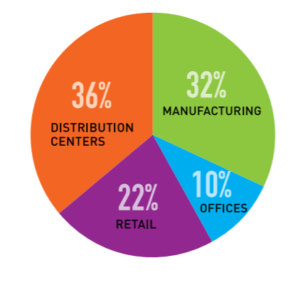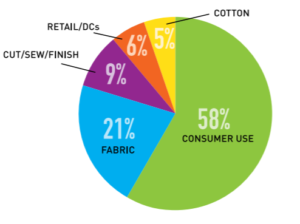But I thought jeans were tough? How could climate change harm them too?
The jeans made by Levi Strauss & Co. are known for their high quality and durability. However, they are facing a major threat from an unlikely opponent, climate change. Can Levi’s protect their prized product from this threat?
How could climate change possibly impact a company that makes jeans?
While Levi Strauss & Co. is a fashion brand, it is highly dependent on the agricultural industry. The key material used in the production of the clothing produced by Levi’s is cotton. In fact, cotton accounts for 95% of the material used up in the supply chain of Levi’s. [1] Like other crops, cotton is at great risk due to the negative impacts of climate change, whether it is from changes in temperature, lower water supply, or increased frequency of catastrophic weather events like droughts or hurricanes. Together these phenomenons could have a multiplier effect that would greatly harm the production of cotton. For example in the United States, the third largest producer of cotton in the world, climate change is expected to change weather patterns by way of increased incidence of extreme weather events and frequency of high temperature days. [2] This will have a particularly negative impact in cotton yields in the Southwest US where the production is highly dependent on water supply for irrigation. [3]
Levi Strauss & Co.’s reliance on cotton exacerbates the problem due to the fact that the manufacturing and distribution of cotton products contributes to the emissions that are causing climate change to happen in the first place. Cotton production accounts for up to 1% of the total greenhouse emissions across the globe. [4] Manufacturing and distribution are responsible for the bulk of greenhouse gas emissions emanating from Levi’s supply chain. (Figure 1 shows the 2011 breakdown of emissions by supply chain stage at Levi’s)
Figure 1 [5]
Climate change also poses a threat to the rest of the supply chain because their manufacturing facilities are located in developing countries like India and Vietnam, in which the negative effects of climate change are already noticeable. [6]
How has Levi’s addressed these concerns?
In 2012 Levi’s announced a plan to confront the threats posed by climate change on two fronts. First, they sought to decrease their greenhouse gas emissions across their operations and their supply chain. In the short to medium term they announced three key goals: cut emissions in all steps of the supply chain excluding manufacturing by 25% by 2020, set a target of an annual 5% reduction in emissions per unit in the manufacturing process, and set out to purchase 20% of their energy from renewable sources by 2020. [7] Their long term goal is to eventual purchase 100% of their energy from renewable sources. [8] This increased energy efficiency would also benefit their bottom line, they saved $1.3 million in energy costs alone in their distribution centers from 2007 to 2011 by cutting emissions by 27%. [9]
Levi’s realized that they alone can’t make enough of a difference to combat the threats posed by this megatrend. Therefore they have both helped found or joined advocacy groups aimed at increasing commitments to reducing emissions amongst businesses and governments. [10]
Levi’s has also focused on reducing the emissions due to their suppliers through their supply chain. They collect water and energy usage data from the 63 highest volume and strategic partner in order to asses the sustainability strategies in place and to share best practices. Levi’s ranks the suppliers and provides each of them with a one-page assessment of their energy and water use per unit. [11] These efforts led a large number of their suppliers to reduce their emissions by 30% by 2012, and Levi’s has kept up the annual reports and rankings since then. [12]
What else and they do?
Due to the negative impact of cotton production, manufacturing, and distribution, I would recommend Levi’s strongly investigate the potential to lessen its dependence of cotton as its main material. This will also be important as cotton yields decrease due to climate change and prices increase. If they can reduce their need for cotton and promote the use of a more sustainable raw material, they will really be able to have the positive impact on the environment and their costs that they are striving for.
In the end, how much can they really do?
Looking ahead, the main question I have is how much can Levi’s really do to affect the necessary change. As Figure 2 shows, the consumers are responsible for the majority of emissions in the product life of a pair of jeans.
Figure 2 [13]
Can the “Care for Our Planet” campaign [14] really do enough to educate people on more sustainable product care practices and more importantly, motivate them enough to actually implement them in their lives?
(761 words)
[1] Levi Strauss & Co. “2012 Climate Change Strategy,” Levi Strauss & Co. Company Website, September 2012, http://levistrauss.com/wp-content/uploads/2014/01/2012-Climate-Change-Strategy.pdf, Accessed November 2017
[2] Peter Ton, “Cotton and Climate Change: Impacts and Options to Mitigate and Adapt,” International Trade Centre, July 2011, http://www.intracen.org/Cotton-and-Climate-Change-Impacts-and-options-to-mitigate-and-adapt/, Accessed November 2017
[3] Jennifer Chu, “Climate change to deplete some US water basins used for irrigation,” Massachusetts Institute of Technology, https://www.sciencedaily.com/releases/2017/07/170712110454.htm, Accessed November 2017
[4] Peter Ton, “Cotton and Climate Change: Impacts and Options to Mitigate and Adapt,” International Trade Centre, July 2011, http://www.intracen.org/Cotton-and-Climate-Change-Impacts-and-options-to-mitigate-and-adapt/, Accessed November 2017
[5] Levi Strauss & Co. “2012 Climate Change Strategy,” Levi Strauss & Co. Company Website, September 2012, http://levistrauss.com/wp-content/uploads/2014/01/2012-Climate-Change-Strategy.pdf, Accessed November 2017
[6] Ibid
[7] Ibid
[8] Ibid
[9] Ibid
[10] Ibid
[11] Ibid
[12] Ibid
[13] Ibid
[14] Ibid





I agree with you that it is not clear how significant of an impact Levi’s can have on climate change; however, as you mention, the company can do a few things to decrease its dependence on cotton or increase cotton’s resilience to climate change. For example, it could look into one of the new technologies being developed as synthetic substitutes for cotton and it can focus on BCI approved cotton that requires less water and therefore is less affected by drought.
While I agree that the initiatives Levi’s implements internally will not be able to reverse the impacts of climate change on cotton, I think Levi’s can use its position to inform consumers. Levi’s could implement the same type of forward integration with their consumers that they tried on their suppliers by identifying the specific behaviors which contribute to climate change and suggest ways of fixing them. Many consumers do not understand or put much importance on their impact on the environment relative to the impact made to the environment by everyone else. If consumers understood that they were the problem and understood how specifically they could change, I think they would be more receptive to change. If Levi’s has already studied this to determine 58% of the problem is due to the consumer, they should share their findings more specifically to enact change.
I think you did a great job explaining the size of Levi’s jeans climate impact based on cotton material usage. Another statistic I’ve seen is that “one pair of denim jeans produces 44 pounds of greenhouse gas emissions, equivalent to driving a car almost 48 miles or burning over 21 pounds of coal” [a]. It is great to hear that Levi’s is making strides in reducing its carbon footprint and is a leader in the jeans retail space. As Mel outlines above, there remains an opportunity to involve the consumer in their efforts. Upon further research, it appears that Levi’s is “closing the loop” by encouraging it’s customers to recycle old clothing. Levi’s offers customer discounts for the items that are returned to the store. These items are donated to a recycling facility that either resales the item or re-purposes the materials for other use. I’d like to see Levi’s take initiative in share its’ best practices across the jeans industry to support a larger breadth of change.
[a] https://globenewswire.com/news-release/2017/07/20/1054971/0/en/New-Campaign-Targets-Top-Denim-Companies-Over-Carbon-Emissions-Environmental-Impact.html
[b] https://qz.com/459815/levis-just-made-it-incredibly-simple-for-americans-to-recycle-their-old-clothes/
This post is quite educational for me as a consumer! I do agree with the steps Levi has taken to combat the climate change. Other than leading by example in adopting sustainable measures and educating the consumers, I think Levi can promote recycling of jeans so we control the number produced overall in the world (http://www.greenpeace.org/international/en/news/Blogs/makingwaves/fast-fashion-drowning-world-fashion-revolution/blog/56222/).
Levi can also work with farmers on the latest irrigation and water harvesting techniques in the key countries to produce cotton in more eco-friendly way. Dutch aWEARness, creates clothes from 100% recyclable polyester. It uses 95% less water & 64% less energy during production than standard cotton.